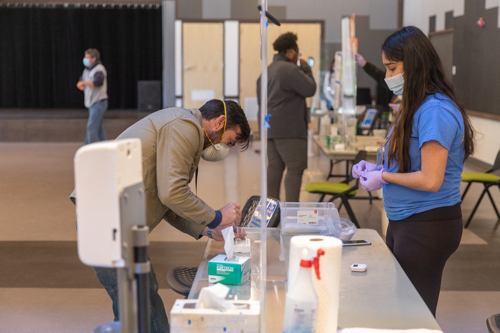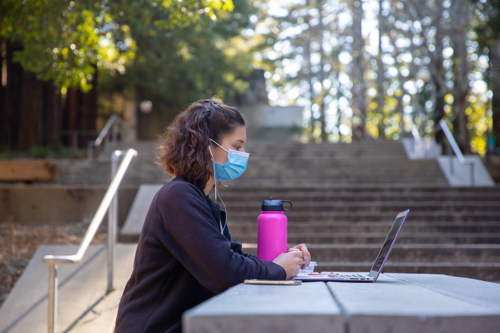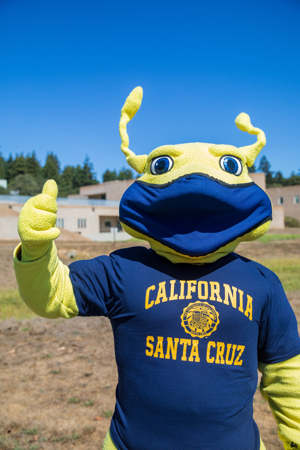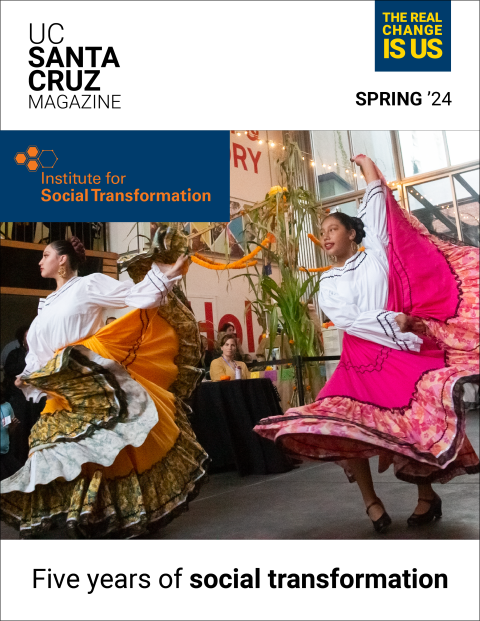In March 2020, when the number of COVID–19 cases began increasing in the United States, UCSC employees quickly shifted into new roles to meet the campus’s emerging needs due to the pandemic.
Student Health Services (SHS) switched to delivering many of its services through telehealth and rapidly built up its COVID-related support, which included hiring a nurse dedicated to overseeing COVID cases and working closely with UCSC leaders in the campus response.
Pharmacy staff started making hand sanitizer, and four COVID testing sites were set up across campus with staffing supervision from the Summer Conferences team. Student Health Outreach and Promotion (SHOP) employees also trained more than 60 student workers to staff the testing sites, while SHS staff from case management, nursing, nutrition, and others, along with the workers’ compensation manager, took on the critical job of contact tracing and transferring students quickly to isolation and quarantine spaces.
The result: Low positivity rates. Zero on-campus transmission. Fast testing turnaround times. For these reasons and many others, UC Santa Cruz is leading the way in efficient coronavirus response compared to its university counterparts.
Testing lab: a community partner
Another notable success in its work for campus and the entire Santa Cruz community is the university’s Molecular Diagnostic Lab (MDL), which opened in May 2020 in response to the pandemic. The MDL hired professional staff and lab scientists to support day-to-day testing for the university and worked with SHS to design the sample collection kiosks that allow for twice-per-week testing of asymptomatic students, as well as voluntary testing of faculty and staff.
“I am so proud of our faculty, staff, and students who have stepped up to serve our campus and our local community, building on the university’s transformative research and resources to establish a COVID–19 testing lab,” said UCSC Chancellor Cynthia Larive. “UCSC’s work has been critical to serving our students and staff as well as the underserved populations in our county who need it most.”

Faculty, staff, and students who show no symptoms of COVID-19
can get free, rapid tests on campus. (Photo by Carolyn Lagattuta)
When the urgent need arose for greater access to testing early in the pandemic, the MDL, with the Community Foundation Santa Cruz County’s support, began to process specimens for the two largest community clinics in the county, Santa Cruz Community Health and Salud Para La Gente. The MDL also began providing test results for other high-risk populations in the community, such as the Santa Cruz County Jail and the Santa Cruz County Probation Department.
“The world is in crisis, we care about the community, and we wanted to do our part to change the testing landscape,” said Director Isabel Bjork. “It was very much a shared interest, and all of us volunteered our time on top of our other full-time positions to make this dream a reality.”
As the pandemic spread, testing lagged, with some sites taking a week or more to deliver results. The campus team has taken pride in providing results in 24–48 hours while expanding its capacity. The lab now processes an average of 1,000 tests a day. The lab was honored with a “Be the Difference” Award for its work last fall by the Santa Cruz Volunteer Center.
Workplace preparedness
When public health guidelines for COVID–19 rapidly changed, the Risk and Safety Services department led the campus response. Managers and staff in the Office of Emergency Services, Environmental Health & Safety (EHS), and Risk Services pivoted to support essential workers on campus by distributing more than 31,000 pieces of COVID supplies, including personal protective equipment (PPE), hand sanitizer, and disinfectant.
This effort was supported by the purchasing, stores, and other staff in Physical Planning, Development & Operations (PPDO), and the team conducted COVID-related workplace assessments and did online training on safety practices for at-home employees to reduce virus transmission. Members of this team also helped implement the campuswide signage program, including the “Slug Strong” awareness campaign, and implemented heightened standards for cleaning and sanitizing workspaces throughout the campus.
Vaccines, helping campus residents
The university recently began administering COVID vaccinations, putting more than 2,000 shots in UCSC employees’ arms to date. In the near future, UCSC will transition to working with the county to inoculate more of the campus population through their healthcare providers and local pharmacies as part of the state’s vaccination efforts.
UCSC has also been fortunate enough to have had lower positivity rates than the rest of the county. Several protective measures, including the decision to delay students coming back to campus in spring 2021, and transitioning to a rolling move-in, seem to have helped curb on-campus virus transmission to date.
At the start of the pandemic, Colleges, Housing and Educational Services (CHES) had the necessary job of rethinking housing density, cleaning, and health protocols to accommodate 800 residents in fall 2020 and 1,300 residents in winter 2021 in single-occupancy residence hall rooms and single- and double-occupancy apartments. Residents are asked to sequester for two weeks at home before coming to campus and for two weeks upon arrival, and the university implemented a badge system and symptom checker to monitor residents’ health.
CHES also created a quarantine and isolation program with wraparound student support. Quarantine housing limits contact between someone who may have been exposed to the virus to others in the community, while isolation housing refers to those who are COVID-positive and showing symptoms and need to live separately. The department created a brochure to demystify this process for students and let them know that they would be comfortable and supported in quarantine or isolation.
The campus made space for isolation and quarantine housing in the Village and other residential facilities across campus. The residents receive meal delivery by UCSC Dining, the spaces are cleaned and sanitized by custodial staff who received specialized training, and students receive support for their academic and personal well-being. The rooms are also equipped with a PPE kit: a thermometer, face covering, gloves, and hand gel. There are now 220 isolation spaces available on campus in case of a surge.
In an effort to avoid an increase in cases such as those that followed the Thanksgiving and winter breaks, the campus is encouraging students not to travel for spring break.
“We realize students may have a desire to travel, but we are asking them to reconsider their plans and have a staycation with us on campus,” said Housing Services Executive Director Dave Keller. “We are planning fun spring break events, such as outdoor movie nights and spring break destination–themed dining, like Cancun Night and Lake Havasu BBQ Night.”
A sense of belonging
College Student Life staff have been working hard to provide a sense of belonging on campus through online and remote programming. For example, when students enter into quarantine/isolation housing, they get assigned a “quarantine buddy,” a staff member at their home college. The staff member will check in regularly with the student to be a point of contact, see how they’re doing, see if they need anything, and provide comfort or resources as needed.
Students also have a staff coordinator who makes contact with students when they need to enter into quarantine/isolation housing. They work on transportation and food coordination, and they work with each student on their unique needs. Counseling & Psychological Services (CAPS) is also working with students struggling with the stress of COVID, remote learning, isolation, and maintaining good mental health during a pandemic.
“It’s safe to say we all miss being able to gather in groups and look forward to that time again. Until then, we’ve learned to utilize social media platforms to advertise and share live events,” said Alex Belisario, interim executive director of college student life. “Colleges have college government meetings via Zoom, we’ve had our first remote College Night, there are movie screenings, virtual speakers, arts and crafts, and larger-scale day-long conferences. The goal is to provide space for and create community.”



